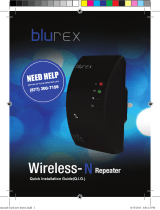
© Copyright 2013 TRENDnet. All Rights Reserved.
TRENDnet User’s Guide
Table of Contents
i
Table of Contents
Product Overview ........................................................................... 1
Package Contents .......................................................................................................... 1
Features ......................................................................................................................... 1
Product Hardware Features........................................................................................... 2
Application Diagram ...................................................................................................... 3
Basic Access Point Setup ................................................................. 4
Expanding a Home Network .......................................................................................... 4
Basic Installation ............................................................................................................ 5
Connect additional wired devices to your network ....................................................... 7
Access your access point management page .................................... 8
Choosing your device mode ............................................................. 9
Access Point (AP) Mode ................................................................................................. 9
Set the device to access point mode ................................................................. 10
Using access point mode ................................................................................... 10
Wireless Networking and Security ..................................................................... 12
How to choose the type of security for your wireless network ......................... 12
Secure your wireless network............................................................................ 13
Connect wireless devices to your access point .................................................. 15
Connect wireless devices using WPS ................................................................. 15
Steps to improve wireless connectivity ............................................................. 18
Multiple SSID...................................................................................................... 19
Allow/deny multicast streaming ........................................................................ 20
Advanced wireless settings ................................................................................ 21
Wireless Bridge (WDS) Mode ...................................................................................... 22
Wireless Bridge (WDS) with Access Point (AP) Mode .................................................. 24
Planning for Wireless Bridging (WDS) ................................................................ 26
Creating a Wireless Bridge (WDS) ...................................................................... 28
Bridging additional WDS supported devices ...................................................... 30
Additional WDS Options .................................................................................... 31
• Lazy WDS .................................................................................................... 31
• WDS Site Survey ......................................................................................... 31
• Spanning Tree Protocol .............................................................................. 31
Wireless Range Extender (AP Repeater) ..................................................................... 32
Set the device to wireless range extender (repeater) mode ............................. 33
Using wireless range extender (repeater) mode ............................................... 33
Client Bridge ................................................................................................................ 35
Set the device to client bridge mode ................................................................. 36
Using client bridge mode ................................................................................... 36
Access Control Filters .................................................................... 38
MAC Address Filters .................................................................................................... 38
Advanced Access Point Setup ........................................................ 39
Change your access point login password ................................................................... 39
Change your device name ........................................................................................... 39
IPv6 Connection Settings ............................................................................................. 40
Change your access point IP address ........................................................................... 40
Set up the DHCP server on your access point ............................................................. 41
Add a DHCP reservation .............................................................................................. 42
Allow/deny multicast streaming.................................................................................. 43
Set your access point date and time ........................................................................... 44
Create schedules ......................................................................................................... 45
Access Point Maintenance & Monitoring ....................................... 46
Reset your Access Point to factory defaults ................................................................ 46
Access Point Default Settings ...................................................................................... 46
Backup and restore your access point configuration settings ..................................... 47
Reboot your access point ............................................................................................ 47
Upgrade your access point firmware .......................................................................... 48
Wireless Client List ...................................................................................................... 49




















